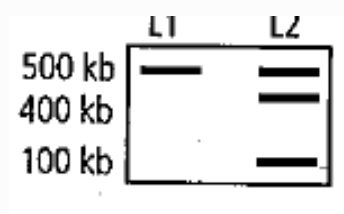A : Unknown DNA after hybridization with VNTR probe, the autoradiogram gives may bands of differing sizes in DNA profiling .
R: These bands represents DNA fingerpint of organism.
If both Assertion & Reason are True & the Reason is a correct explanation of the Assertion.
If both Assertion & Reason are trur but Reason is not a correct explanation of the Assertion.
If Assertion is True but the Reason is Flase.
If both Assertion & Reason are false.
The correct Answer is:C
Step by step video & image solution for A : Unknown DNA after hybridization with VNTR probe, the autoradiogram gives may bands of differing sizes in DNA profiling . R: These bands represents DNA fingerpint of organism. by Biology experts to help you in doubts & scoring excellent marks in Class 12 exams.
Updated on:21/07/2023Topper's Solved these Questions
- GENETICS & MOLECULAR BASIS OF INHERITANCE AND MUTATIONBOOK - ALLENCHAPTER - GENETICS & MOLECULAR BASIS OF INHERITANCE AND MUTATIONEXERCISE - EXERCISE-III (ANALYTICAL QUESTIONS
85 Videos
- GENETICS BOOK - ALLENCHAPTER - GENETICS EXERCISE - Question
58 Videos
- GENETICS (PRINCIPLES OF INHERITANCE AND VARIATION) (MOLECULAR BASIS OF INHERITANCE)BOOK - ALLENCHAPTER - GENETICS (PRINCIPLES OF INHERITANCE AND VARIATION) (MOLECULAR BASIS OF INHERITANCE)EXERCISE - Question
53 Videos
Similar Questions
[A]: The base ratio (A+T )/(G+C) is constant in a particular organism.
[R]: The ratio is, however, different in the dif- ferent DNA molecules
View SolutionAfter electrophoresis the separated DNA fragment can be visualized ethidium bromide gel exposed UV light . These DNA fragments appear as _______ coloured bands :
View Solution
Knowledge Check
Study the given figure carefully and select the incorrect statements regarding this.

(i) It represents a typical agarose gel electrophoresis in which lane 1 contains undigested DNA
(ii) Smallest DNA bands are formed at A and largest DNA bands are formed at B
(iii) The separated DNA fragments can be visualized after staining in the visible light
(iv) The separated DNA bands are cut out from the agarose gel and extracted from the gel piece. this step is known as elution.A(i) and (ii)B(ii) and (iii)C(ii) and (iv)DPerson can see the bands without staining.The figure shows the restriction enzyme cutting sites (R1−R3) in wild type (n) and mutant (n) gene.

If a radioactively labelled probe (that hybridises at a sequence close to R1) is used for detecting the presence of DNA fragments after gel electrophoresis and Southern blotting, which of the following band patterns will yout expect ?
Note : L1 : wild type DNA, L2: mutant DNAA(a) B(b)
B(b) C(c)
C(c) D(d)
D(d)
After electrophoresis the separated DNA fragment can be vishualised ethidium bromide gel exposed UV light . These DNA fragments appear as _______ coloured bands :
View SolutionA mixture of fragmented DNA was electrophoresed in an agarose gel. After staining the gel with ethidium bromide, no DNA bands were observed. What could be the reasons?
View SolutionA plasmid DNA and linear DNA (both are of the same size) have one site for restriction endonuclease. When cut and separated on agarose gel electrophoresis, plasmid shows one DNA band, while linear DNA shows two fragments Explain.
View SolutionA plasmid DNA and a linear DNA (both are of the same size) have one site for a restriction endonuclease. When cut and separated on agarose gel electrophoresis, plasmid shows one DNA band while linear DNA shows two fragments. Explain
View SolutionA mixture of fragmented DNA was electrophoresed in an agarose gel. After staining the gel with ethidium bromide, no DNA bands were observed. What could be the reason?
View Solution
